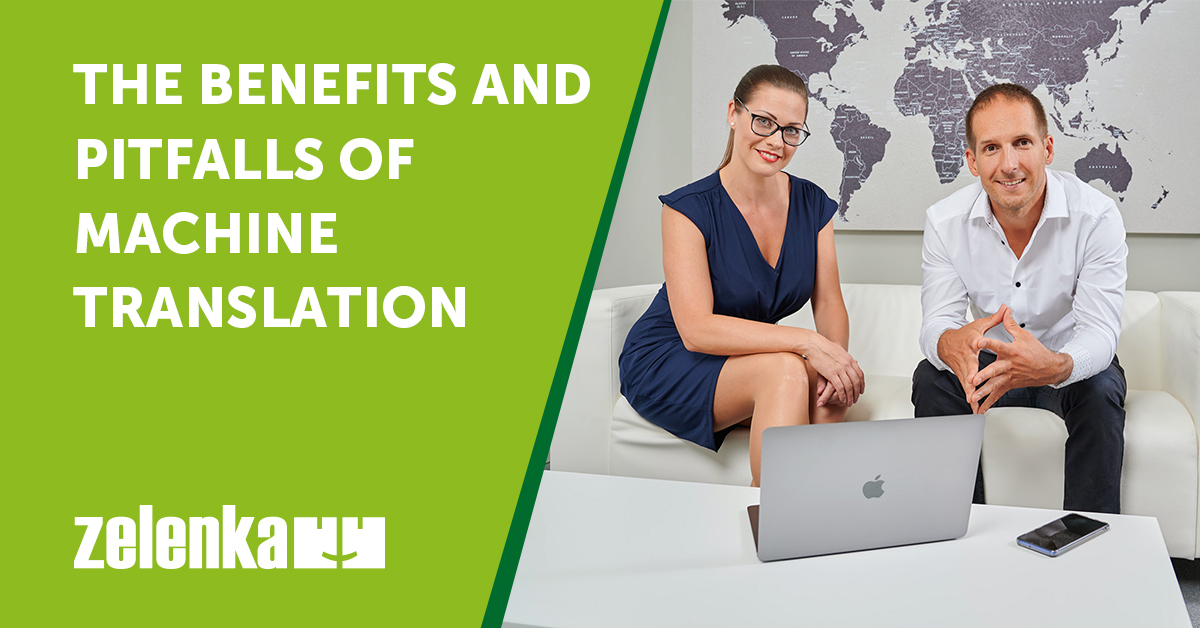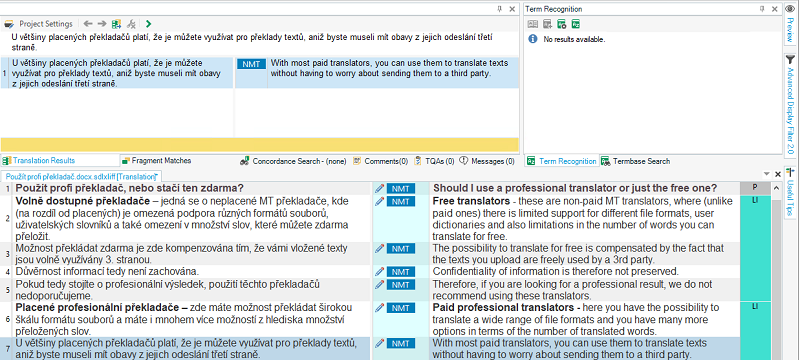The Benefits and Pitfalls of Machine Translation

Michael Borkovec
24. 10. 2022Just about everyone has run into “MT” or “Machine Translation” by now. If you’ve ever had a text translated by, for example, Google Translate, then you’ve used machine translation before. The main benefits are clear: A low (or even zero) translation cost as well as swift turnaround (your text is translated almost immediately).

However, these advantages come at the price of some disadvantages. For example, the need to “train” the MT engine against a large quantity of text so that its translations can be high-quality.
Should I Use a Pro MT, or Can I Get by with Free?
- Free MT tools – these are the machine translation tools available free-of-charge where (unlike with paid tools) you’ll suffer from limited support for various file types and user dictionaries, and also limitations to how many words you can translate for free. Here the chance to translate for free is compensated for by the fact that the texts you supply can be freely utilized by a third party. So the information you provide does not remain confidential. This can even amount to a violation of the EU’s General Data Protection Regulation (GDPR). So if you care about professional results, we recommend against these translators.
- Paid professional translators –here you are able to translate a wide range of file formats, and you also have many more possibilities in terms of the number of words translated. With the majority of paid MT tools, you can use them for translating texts without having to worry they’ll be sent on to a third party.
The selection of paid MT tools is a rich one today, and some are of very high quality – but there are also tools with a suspicious background, and it can be hard for a layman to tell which are trustworthy and high-quality. That’s why we recommend at least consulting with an expert or going straight for a professional translation agency.
Every honest agency will only use MT tools that have verified high output quality and the ability to work hand-in-hand with human translators’ CAT tools. This gives you access to practically unlimited support for a variety of formats, custom dictionaries, and professional specializations. These agencies also have contractually guaranteed confidentiality, so you don’t need to worry that someone will see your texts without your permission.
How to Train Your Translator, or: What about Specialised Terminology?
For an MT tool to be able to use the right specialised terminology, it is essential to “feed” that terminology into it. Professional translation agencies use their own MT engines that do not share translated texts with third parties and are also specialized to a specific field.
Precisely this need to “teach” these machine translators with enough text can be viewed as a disadvantage of MT. This step is essential, because otherwise the output will be low-quality. This is a clearly demanding task: For the “general training” of an unspecialised MT tool, we’re talking about tens of millions of translated sentences, and to specialise one for a field after that, it takes additional hundreds of thousands.
Free tools, on the other hand, are not focused on any specific field and are only suitable for general texts (e.g., emails – but even here remember that you may be sharing sensitive data with a third party).
Example of working with machine translation in Trados Studio

Back to professional MT tools. The way the “learning” process works is that the universal (so far) translator is provided with a large number of already translated texts from a specific field (e.g. from machine engineering), against which it is “trained.” Or more precisely, the universal translator becomes one specialized for a specific field. This makes its translations much more stylistically and terminologically precise than they would be without this “training.”
There’s an analogy here with human translators: once a translator has finished translation studies, they know how to translate – but only general texts. Only after years of practice and/or further education can they orient themselves well enough in the matters of a given field (e.g., construction, economics, law, finance, etc.).
With MT, it is also important what kind of text you want to translate and how it will be used. Literary and marketing texts and other stylistically demanding texts are inappropriate for machine translation. This is because MT uses quite a dry linguistic style.
Machine translation is thus a good choice for stylistically undemanding texts such as translations of technical manuals, user guides, technical specifications and standards, etc.
High quality only comes after a translated text has been edited by a “live” translator
So we’ve found a text that is suitable for machine translation. And also an MT tool based on the latest technologies – and we’ve even “trained” it for our specific field. And what comes next? Do we just pop in a file, press a key, and everything’s done?
No, unfortunately. Because machine translation itself is just the first step.
The next step – and it’s a critical one – is editing of the MT tool’s output. It may seem at first that the output from MT is high-quality enough that you don’t need to touch the text from there. But that’s wrong. Raw MT output sometimes contains very serious errors – these can include changed meanings, omitted words, and more. And furthermore, in some fields, errors like these are completely inadmissible (especially in cases where a translation error can cause injuries or loss of life).
With a “traditional” translation, a text is typically translated by one translator and then revised by another. That is also how it should work for an MT translation: it is sent to a “human MT post-editor” (= the MT output will be “post-edited”), and then also reviewed by a second translator.
Traditional translation differs from MT post-editing in several key respects, and so it is essential to ensure good training for the “post-editor” and compliance with recommended rules. And indeed that’s why we organize periodic training sessions for our translators.
How does machine translation fit into our palette of services?
If a customer decides to use MT, we offer two translation levels where MT can be used, which can be described like this:
- Basic – If the text is only needed for internal informational purposes (it will not serve for public presentation or in a role where high information quality is important), or if you are only planning to use the translation as the foundation for preparing a new text, you can go for the Basic When we’re talking about MT, this variant means the output from the MT tool will only be post-edited by a single translator.
- Standard – The text is first machine-translated by the tool, then a “live” post-editor checks it, and then another translator revises it.This is the most frequently ordered service level, because it provides sufficient quality for the majority of texts (e.g., technical manuals, contracts, standards, business communication, )
Naturally even here you can ask the question: Isn’t just the RAW MT output without further editing by “human” translators enough? Unfortunately, it isn’t – even the best MT tool will occasionally make fundamental mistakes that can have serious impacts on the text and on its readers.
That’s why you should be very cautious toward the offerings of agencies that offer “Light MT post-editing.” This is only a very quick check of the MT output, during which the raw MT output – i.e., the translation – is not checked against the original text, and thus these truly fundamental errors can remain.
What Will Machine Translations Look Like Tomorrow?
It can be expected that translation services will gradually self-specialize into three areas.
- The first will work on traditional translations without the use of MT – they will cover stylistically very demanding texts and highly specialized fields.
- The second area will be all about MT outputs with subsequent MT post-editing and revision. This will be used mainly for technical and legal texts. The output quality will be the same as the translations of today.
- In the thirdarea, the emphasis will be on maximizing cost savings and the search for a compromise between price and quality. Most likely this will mean the route of only very rapid (or even no) checks of MT output. However, this approach will only be possible once the quality of MT tools has increased fundamentally. We definitely cannot recommend this approach today.
However, if you really have no choice, at least limit your use of raw MT output to unimportant texts and/or internal informational materials only. For raw MT output, it is in short impossible to guarantee a text’s quality, and it can end up being misunderstood, which in many situations can have fatal consequences.
So, does it pay off to use professional machine translation tools today? Definitely!
If you order the services of a professional translation agency that uses MT for the types of jobs where it works well, you’ll enjoy two benefits compared to a “traditional” translation:
- Lower prices for translation
- Faster work for the translation itself (especially for large projects)
And that pays off. :-)
If you’re interested in more information on machine translations, let us know. We’ll be happy to discuss a customized solution for your project.


